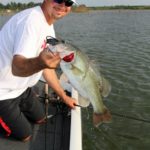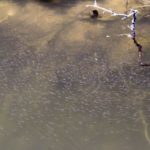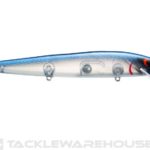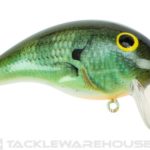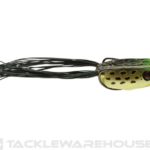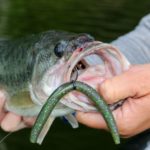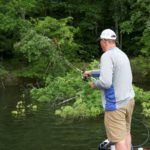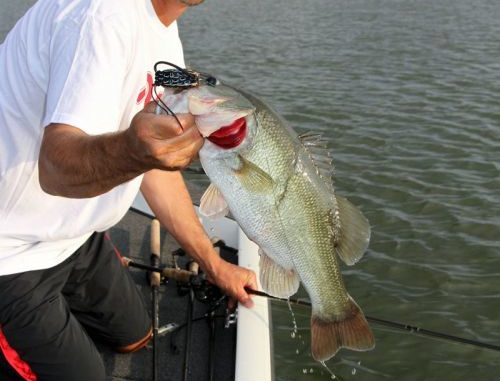
Bass’ instincts can be their downfall in the spring
It’s like girls night out for new mama bass and dads are watching the kids. That’s basically the deal with a popular spring pattern we know as “fry guarders” — male bass round up recently hatched babies (fry) and keep constant watch for a host of predators from bluegill, to crappie to other bass.
Suffice it to say that this round-the-clock job of corralling a bunch of inexperienced young’uns given to wandering and preventing their demise keeps the protective papas in a constant state of agitation and irritability. You’d think that would equal immediate bites, and sometimes, it does. But stay sharp when trying to fool a bunch of dads who are responsible for ensuring the survival of their offspring.
Seeing is believing
Making visual contact with a fry guarder is the simplest, but not necessarily the easiest method. If you’re looking at a fish, he’s already looking at you, so be aware of your proximity. Keep your shadow off the fish and stand still in the boat to minimize sending out disturbing pressure wakes.
Now, you have to find the fry and considering how God designed them to blend in with shallow cover, you typically have to stumble across a cluster of them. Plenty of times anglers just happen to look down and notice a bunch of tiny bodies and one big shadow below, but Bassmaster Elite Series pro Jason Christie said a diligent bank plowing effort often causes fry to show themselves.
“I want to fish baits that will move that fry and once you see them scatter, you know there’s (an adult bass) in the area so you’d better get ready,” he said. “That fry is usually going to be on the surface so I like to fish things that are going to be on the surface or above that fish’s head.
“You have to put yourself in that bass’ shoes; his job is to guard that fry and once the sun gets up, he’s going to push them to a place where he can protect them — a laydown, a bush, behind a dock.”
For finding the baby bass and for taunting fry guarders, Christie likes a bold and noisy Rebel Pop-R, a Booyah Pad Crasher frog, a floating Smithwick Rogue or a Bandit Footloose wakebait — baits that disrupt the surface and convince a bass that his young are under attack. Here, Christie is constantly scanning the bank through polarized sunglasses and watching for not only the silver shards, but also the movement of protective bass.
“Fry guarders are pretty good at giving themselves away,” Christie said. “You’ll see them chase off a perch. So this time of year, it’s good to be looking all around you because it just takes one little hint, one little swirl to find that fish’s location.”
When FLW regional pro Nick LeBrun finds a fry guarder, he typically fares best with a finesse presentation. His tool of choice is an unweighted V&M Chop Stick wacky rigged on a 1/0 Gamakatsu Wicked Wacky hook.
“Sometimes, I’ll use 17-pound fluorocarbon line because it holds the bait up higher and falls more slowly than if I were using 8- to 12-pound,” he said. “If the water is super clear, you may not get bit as much on bigger line, so it’s a two-edged sword. Sometimes, you have to play around with your line size to find the right fit.”
For sight fishing, it’s no surprise that Lebrun favors lots of sunshine and light wind. However, he stressed that he’s not interested in flat calm conditions, because the same window that shows the fish to you, also shows you to the fish. A little chop, Lebrun said, improves his optimism because he knows the fish’s vision is also obscured.
“Just like sight fishing them on a bed, you have to realize that you’re not going to be able to catch all of the fry guarders you see,” he said. “I’ll try to get a visual reference on the fish, back off as far as I can and blind cast to him.”
Another trick: Lebrun will flip a Texas-rigged bait into the area where the fry are holding, let it drop in front of the protective fish in hopes of lighting its fuse. He rarely expects to hook a fry guarder on a Texas rig, but just like agitating a bed fish with an oversized bait before sending in the deal closer, this tactic can push reticent fish into attack mode.
Zone of interest
In some instances, conditions such as cloudy skies and/or windy conditions will prohibit you from “looking at ’em.” This definitely requires some tactical adjustment, but it’s not necessarily a bad deal.
Consider that if you can’t see the fish, his view is also diminished. Whether or not it’s a conscious decision, fish tend to relax more when they sense decreased visibility.
“You may know that there’s some fry in the area but maybe it’s early in the morning or maybe the water is muddier,” Lebrun said. “You get a glimpse of some every once in a while and you’re just blind casting.”
Lebrun agrees and notes that if he intends to return to a fry guarder the following day, he’ll log the precise location and note any relevant details of weather, sun angle, etc. on the Exact Cast Bass Fishing app he created last year. Available for iOS and Android, this app allows anglers to snap a photo of what they’re looking at, log relevant data about the spot and conditions and then save it all together for future reference.
“Maybe the next day, I’ll go to that spot early and throw something like a 6th Sense Crush Dogma or a frog to see if the fish will bite early,” Lebrun said. “If you have several fish to manage, you really need to make sure you’re making that exact cast.
“That’s the reason I developed my app; to help us remember that a particular 3-pounder was next to this clump of hay grass next to this log. Being able to make that exact cast gives you the confidence to know that your bait is landing exactly where it was yesterday and the fish is right there under it without having to go up and look and maybe spook the fish.”
Persistence pays
Fine tune your strategy and performance with these perspective points.
Size up the opportunity: “If I come through an area where I know there are fry guarders and I don’t get a bite, I’ll make another cast through it with another bait. If I make three or four casts through it and I don’t get that fish to bite, I’ll get up there and look at the fry to see how old it is.
“It gives you more perspective on what phase of the spawn you’re in. If you’re seeing fry that’s older, you know that this pattern is tapering off. But if I’m seeing fry and a lot of it is really young, I know that I can run that pattern for the next two weeks.”
Drop down: If Lebrun finds a tough fish that won’t commit to biting, he’ll assess the risk/reward equation and determine if the fish is big enough to commit extended effort. If he thinks the stubborn bass will help his tournament effort, Lebrun will downsize his line — even going to 8-pound test on spinning gear.
Second act: “Kind of like sight fishing (for bedding bass), there are certain times of the day when those fish are a lot more aggressive,” Christie said. “So, if you don’t catch it, a lot of times, you can come back and they’ll be in the same area — 20-30 yards in either direction.”
